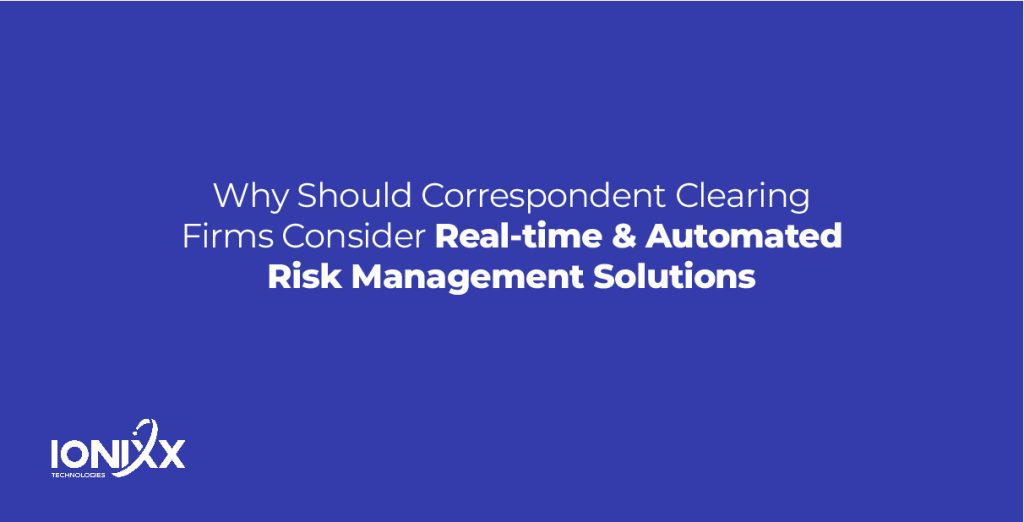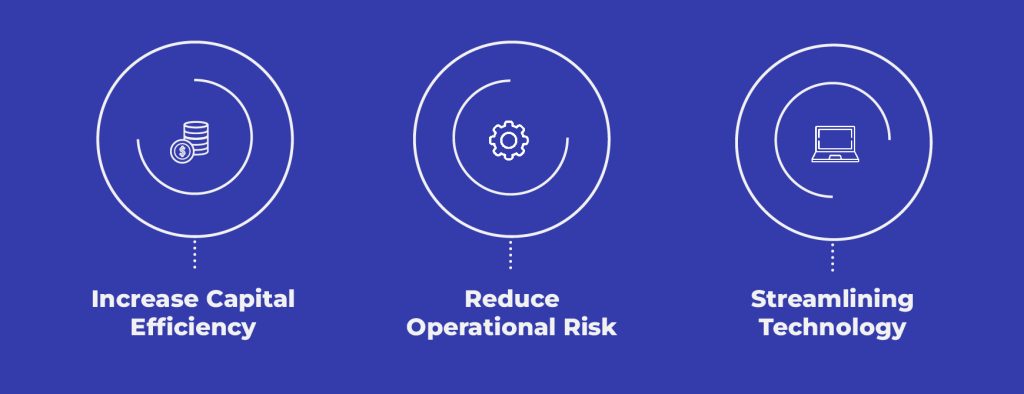
The securities trading industry relies on efficient back-office functions and trade settlements to ensure transactions are correctly executed and adhere to regulatory requirements.
Correspondent clearing firms handle a significant aspect of the post-trade cycle and must manage the associated risks accordingly. For instance, the clearing broker helps maintain the integrity and efficiency of the financial markets while ensuring that all parties involved, including introducing brokers and their clients, comply with applicable regulations. The relationship between introducing brokers and clearing brokers is crucial for the smooth functioning of the securities trading and settlement process.
The Firm Clearing Model – A Collaborative Approach
It is in this context that the firm clearing model and the role of correspondent clearing firms become important. The firm clearing arrangement enables correspondent clearing brokers or introducing broker-dealers to focus on customer relationships, sales, and front-end services while leveraging the services of a larger, more established firm for the efficient processing and settlement of trades. It’s a collaborative arrangement allowing smaller or specialized broker-dealers to offer a broader range of services to their clients by leveraging the capabilities of the firm providing clearing services. These clearing arrangements help optimize costs alongside helping them leverage the benefits of sophisticated technology infrastructure.
The Risk Landscape for Correspondent Clearing Firms And Its Impact
Amidst increased trade volumes, heightened market volatility, and a significant surge in retail investor engagement, the equities market landscape seems to have transitioned to a ‘new normal’. This shift brings forth an elevated level of settlement risk, signifying the increased potential for a trade counterparty to fail in delivering the agreed-upon security or its corresponding cash value. This amplified risk is more relevant within the context of the upcoming T+1 settlement. It directly impacts the correspondent clearing brokers/firms, wherein one broker manages the clearing and settlement of a trade executed by another broker.
The escalating risk exposure for correspondent clearers necessitates the heightened significance of implementing real-time risk controls compared to previous years characterized by lower trade volumes, reduced market volatility, and a smaller contribution from retail investors in the overall trading volume. When introducing brokers entrust their securities trading business to a correspondent clearing broker, the latter assumes the legal risk associated with the transaction. As a result, they are exposed to default risk in the clearance and settlement process. In cases of trade failures, the clearing broker must dip into its capital to mitigate the potential spread of risk across the market.
A broker specializing in sourcing liquidity for trades might lack the necessary infrastructure to effectively manage the post-trade processes. Alternatively, they might prefer to concentrate solely on trade execution without assuming the risks associated with unsettled trades.
This is where the role of the correspondent clearing firm becomes crucial.
Notable brokers in this space, such as Goldman Sachs, National Financial, Broadcort, Hilltop Securities, and Pershing, are recognized for their prowess in providing clearing services. These firms specialize in handling the complexities of trade settlement, enabling other brokers to focus on trade execution without the burden of post-trade risks.
The correspondent broker is required to be equipped with robust risk management systems tailored to assume the responsibilities of clearing transactions in a secure and responsible manner. Leveraging their expertise, they offer this essential service as a fee-based offering to the execution broker. This arrangement allows the execution broker to offload the intricate and risk-intensive clearing processes, providing them the flexibility to concentrate on executing trades while the correspondent clearer manages the post-trade aspects efficiently and securely.
A 2021 SEC report detailed that several broker-dealers encountered intraday margin calls from a clearinghouse. Consequently, in response to this situation, certain broker-dealers opted to impose trading restrictions on a select few individual stocks in a manner that might have been unexpected for certain investors.
Correspondent clearing firms can actively mitigate risks through the adoption of new risk management solutions. The pivotal role of cloud-deployable platforms, emphasizing their rapid setup within days, underscoring the urgency and efficacy in establishing robust risk management systems.
The Need for Enhanced Due Diligence
The US Congress addressed the AML risks of correspondent clearing relationships in sections 311 to 313 of the USA PATRIOT Act. This requires US correspondent clearing banks and brokers to conduct specific enhanced due diligence on relationships with respondent banks or terminate those relationships.
The Need for Real-Time Risk Insights
Given the diverse risk exposures faced by correspondent clearing brokers, the demand for real-time risk management solutions has never been more evident. In the past, many relied on a disjointed array of platforms, limiting their ability to maintain a singular, real-time view of risk. This challenge becomes even more pronounced as the financial industry prepares to transition from T+2 to T+1 settlement in 2024.
The Role of Modern Risk Management Platforms for Correspondent Clearing Firms
Implementing a modern risk management platform is an effective strategy for correspondent clearing firms to reduce risk. These platforms leverage advanced technologies and methodologies to identify, measure, monitor, and mitigate risks more effectively.
By leveraging a modern risk management platform, correspondent clearing firms can proactively identify, analyze, and respond to risks, reducing their exposure to potential threats and fortifying their operations against various uncertainties.

| Comprehensive Risk Assessment | Modern risk management platforms use sophisticated algorithms and data analytics to assess and understand various types of risks, such as credit risk, market risk, operational risk, and compliance risk. |
| Real-time Monitoring | Clearing brokers provide real-time monitoring capabilities, enabling firms to promptly detect and respond to potential risks as they emerge, thus reducing the impact and likelihood of adverse events. |
| Risk Identification And Prioritization | These platforms assist in identifying high-risk areas and prioritizing them, allowing the firm to focus on the most critical areas needing immediate attention. |
| Automated Controls and Alerts | Clearing firms incorporate automated controls and alerts that notify relevant personnel about potential risks or breaches in risk thresholds, enabling a rapid response to mitigate or prevent losses. |
| Scenario Analysis and Stress Testing | These platforms facilitate scenario analysis and stress testing, allowing firms to simulate various market conditions and potential crises to assess their impact on the business, thereby preparing for contingencies. |
| Regulatory Compliance | They aid in maintaining compliance with evolving regulatory standards, ensuring that the firm adheres to industry regulations and compliance requirements, thus reducing regulatory risks. |
| Data Visualization And Reporting | Advanced risk management platforms provide intuitive dashboards and comprehensive reporting tools that offer a clear and comprehensive view of risk exposure and trends. |
| Integration with Overall Business Strategy | Clearing firms align risk management with the overall business strategy, ensuring that risk management efforts support and complement the firm’s objectives. |
Real-Time Risk Management – A Potential Solution
Corresponding clearing brokers can equip themselves with a real-time risk management system that would enable them to:
- Monitor trade activity at regular intervals
- Map trade transactions into the client-defined hierarchy
- Evaluate impact of each transaction for applicable correspondents and generate alerts when client-defined thresholds are breached
- Make the alerts available via a client summary dashboard and emails
An ideal real-time risk management solution not only offers visibility across venues, trades, assets, and accounts but also provides the functionality required to navigate the complex landscape.
Cloud – Driving The Future of Correspondent Clearing Risk Management
Correspondent clearing firms prefer not to delve into the intricacies of managing a real-time risk service themselves. The deployment of a cloud-based Software as a Service (SaaS) solution provides correspondent clearing brokers with the real-time insights they need while supporting infrastructure modernization.
- A cloud-based risk management platform with cutting-edge technological infrastructure enables them to stay ahead in a dynamic securities environment.
- It helps manage risks effectively, and harness new technologies, also offering scalability, and flexibility to seize the right opportunities strength, and integrity of the financial markets.
Automation for Efficiency and Security
Automation streamlines and optimizes various risk management processes, leading to reduced costs, enhanced accuracy, and proactive risk identification. Correspondent clearing brokers can now focus on executing trades while automation handles complex post-trade operations.
A clear case in point is how DTCC successfully reduced manual error rates by 30% after implementing automation in its risk management processes.
How Can Ionixx Help?
The correspondent clearing model plays a critical role in maintaining efficient post-trade functions. It offers a collaborative approach that allows broker-dealers to focus on their core services. Clearing firms, in turn, handle essential back-office functions, ensuring compliance and security. With the increasing complexities and risks in today’s markets, the use of modern risk management platforms is crucial to mitigate potential threats and enhance operational resilience within the correspondent clearing framework.
Essentially, Ionixx takes on the entire IT challenge, offering correspondent clearing firms the peace of mind they need. As a brokerage-focused IT solutions provider, Ionixx delivers robust risk management platforms, empowering correspondent clearing firms with a solution that not only reduces risk but also simplifies the technical complexities associated with real-time risk services. Get in touch to know how we can help you with our risk management and post-trade automation solutions.


